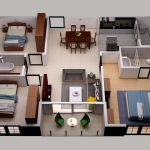DC Equipment
Substation DC equipment located in the control house normally consists of the battery, battery charger, monitoring and control devices, and distribution panelboard.
The battery should be located in a separate room where practical. If the battery cannot be located in a separate room, it should be located so that electrical switching devices and receptacles are not in the immediate vicinity, ventilation is adequate to prevent gas accumulation, and live parts are protected from accidental contact.
The battery charger, monitoring and control devices, and distribution panelboard are normally located in the control and relay room to facilitate cable routing and equipment maintenance.
Detailed design requirements and procedures for the substation DC system can be found in this technical article.

Figure 10 – Left: Battery room; right: Battery chargers
AC Equipment
A low-voltage AC system is provided in the substation for lighting, convenience outlets, heating, ventilating, air conditioning (HVAC) equipment and miscellaneous control functions.
Convenience outlets should be strategically located throughout the control house to provide adequate accessibility. Also, if necessary, workshop and testing area with a high-capacity AC source and a three-phase source should be provided.
For greater reliability, two separate sources may be provided for the AC system service. These sources are often fed through a manual or automatic transfer switch so that ac system power can be restored if one source fails.

Figure 11 – Substation AC Auxiliary Supply For Inessential Loads (on photo: AC auxiliary switchgear 400/230 V.



Comments are closed